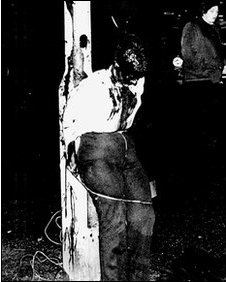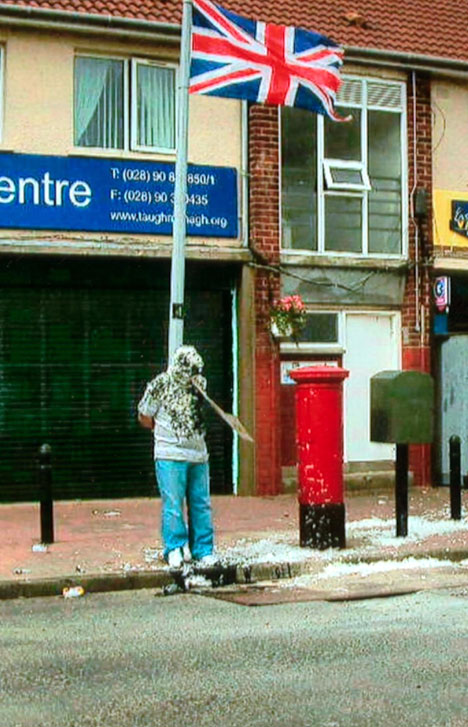Police Distrust and Retributive Justice
The legacy of police distrust among Irish–and particularly physical-force nationalist–citizens has been ongoing long before the Easter Rising, when officers were thought of traitors who decided to forsake Ireland’s independence in favor of serving the British crown. Out of this history of distrust and violence between paramilitary groups has sprung a tradition of vigilante-like justice, here defined as a method of dealing with perceived offenses without involvement of any governmental affiliation like police officers. In practice, while violence has fallen significantly in recent years, the actions taken under the Provisional IRA’s definition of justice has led to deaths and debilitating injuries going unreported in something akin to what Americans would view as “frontier justice.”⁷
This type of punishment can be best understood through the lens of hyper-retributivism, wherein offenders are punished to a further extent than their alleged transgression. Retributivism is an effective method for defining and maintaining authority under fear-based systems of control, which aligns with the actions and much of the public perception of the Provisional IRA.³ The typical effects of this practice also match the realities of North Ireland in the era of the Troubles, including hostility and resentment against the enactors of retributivism.
Kneecapping

While both Protestant- and Catholic-based groups are responsible for numerous acts of heinous vigilantism because of distrust of the police as a force of public peacekeeping, the IRA in particular took on a practice of non-lethal punishment known collectively as kneecapping that included shooting various limbs and joints, beating with bats, chains, and metal bars, and in some cases banishment from a community. A 2010 instance of this practice was carried out by a sect of the provisional IRA called Oglaigh na hEireann against a man they believed to be a drug dealer (the man publicly denied this claim). He was shot four times (in the shin, thigh, ankle, and calf) in his home while the attackers restrained his grandmother in another room.⁶
Tar-and-Feathering

Tar and feathering has taken on a slightly different meaning that kneecapping, as the element of public humiliation has been a focal point in the practice, and the nature of coordination among members of the IRA in particular have led to a feeling of similarity between this practice and lynching by the KKK in its demand to be recognized as a public spectacle. The damage done by this practice is irreparable. Third-degree burns requiring extensive skin grafts as a result of boiling tar being poured over one’s head lead to a notoriety that is physically inescapable. This practice has been implemented in response to supposed offenses ranging from being engaged to a soldier to refusing to store IRA ammunitions in one’s home, the latter case involving a woman who was five months pregnant.¹⁰
Aftermath: Physical Markers of Former Victims
Although variation in the practices exist, the practice of tar-and-feathering has taken up a largely gendered connotation in that it is traditionally enacted against women, while kneecapping is typically a male-oriented punishment. The differences between these two practices are extreme, although both are rooted in their purpose to serve as recurring reminders of the consequences of violating an unwritten social code. Kneecapping was meant to serve as a temporary isolation from society that will ultimately result in a reintegration with the general populace. In other words, this practice can be reasonably viewed as a social handicap, leaving room for a redemption by the male violator of the social code. Tar-and-feathering, by contrast, is seen as a social death for the women who suffer it, who are often subjected to head-shaving and disfiguring burns that create a barrier against in-group inclusion. This readily aligns with the notion presented and reinforced by W.B. Yeats and Patrick Pearse of the representation of women as pure and ornamental in the tradition of Cathleen ni Houlihan. If women are not able to meet this criteria satisfactorily, then, they have no worth as sexual beings or even as respected members of society. Crimes committed by women take a much less direct tone than their male counterparts, with offenses mostly centered on affiliation with government figures and serving as informants against the IRA agenda. You can read more about gendered vigilantism as well as a close reading of Seamus Heaney’s poem “Punishment” here.

The aftermath of tar-and-feathering and kneecapping can permanently disfigure the body, leading to social ostricism that transcends traditional physical markers and becomes a universal repulsion in extreme cases, although most documented cases only report minor burns and scarring. It is important to note that violent acts against men, including attacks by pitbulls, kneecapping, and tar-and-feathering, are usually enacted in retaliation for alleged crime that receive insufficient police attention, unlike the more passive transgressions committed by female victims.¹⁵ The documented causes for attacks against men include drug dealing, rape, and theft. Despite this, it is heavily rumored that paramilitary groups in the Belfast region persecute drug dealers in order to gain a monopoly over the drug supply themselves, creating a cyclical hypocrisy that forsakes traditional government forces in favor of a no-tolerance, community-based method that focuses on physically disabling and ostracizing violators of unwritten social code.

